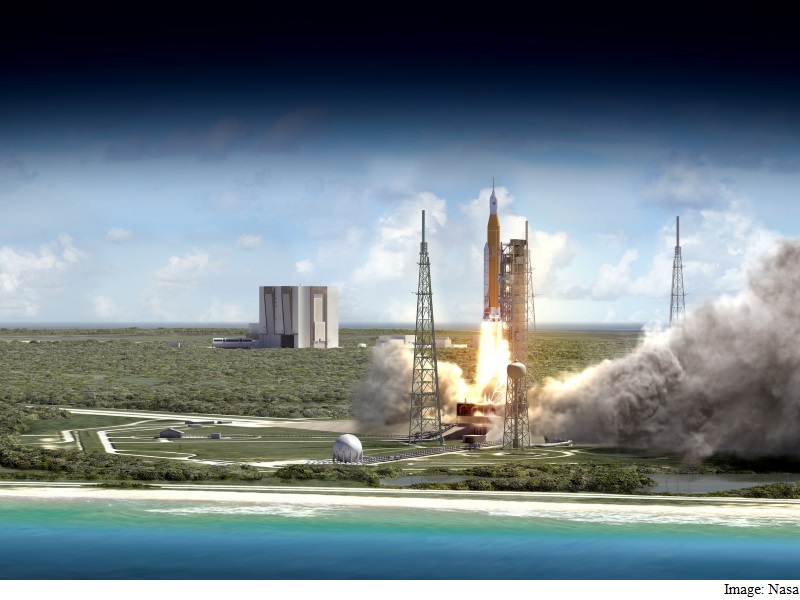- Home
- Science
- Science News
- Nasa's SLS Rocket to Launch 13 CubeSats Alongside Orion in 2018
Nasa's SLS Rocket to Launch 13 CubeSats Alongside Orion in 2018

The main objective of the SLS first mission, which will fly just beyond the Moon, is to evaluate the integrated system performance of Orion and the rocket prior to the first crewed flight, Xinhua reported.
"The SLS is providing an incredible opportunity to conduct science missions and test key technologies beyond low-Earth orbit," Bill Hill, deputy associate administrator for Nasa's Exploration Systems Development, said in a statement.
"This rocket has the unprecedented power to send Orion to deep space plus room to carry 13 small satellites - payloads that will advance our knowledge about deep space with minimal cost," Hill said.
For its first flight, the SLS rocket will be configured for a 77-ton lift capacity, but it eventually will provide an "unprecedented" lift capability of 143 tons, which will enable missions even further into our solar system, including such destinations as an asteroid and Mars.
The small satellites, known as CubeSats, which will fly to deep space as secondary payloads, will pave the way for future human exploration in deep space, including the journey to Mars, as most launch opportunities for CubeSats are limited to low-Earth orbit, Nasa said.
Four of the 13 small satellites will be used to study the Moon, such as looking for water ice, hydrogen and other resources on our nearest space neighbour, said Nasa.
One small satellite called Near-Earth Asteroid Scout, will perform reconnaissance of an asteroid, take pictures and observe its position in space.
One small satellite known as BioSentinel will use yeast to detect, measure and compare the impact of deep space radiation on living organisms over long durations in deep space.
Another one, CuSP, will serve as a "space weather station" to measure particles and magnetic fields in space, testing practicality for a network of stations to monitor space weather.
For the latest tech news and reviews, follow Gadgets 360 on X, Facebook, WhatsApp, Threads and Google News. For the latest videos on gadgets and tech, subscribe to our YouTube channel. If you want to know everything about top influencers, follow our in-house Who'sThat360 on Instagram and YouTube.
Related Stories
- Galaxy S24 Series
- MWC 2024
- Apple Vision Pro
- Oneplus 12
- iPhone 14
- Apple iPhone 15
- OnePlus Nord CE 3 Lite 5G
- iPhone 13
- Xiaomi 14 Pro
- Oppo Find N3
- Tecno Spark Go (2023)
- Realme V30
- Best Phones Under 25000
- Samsung Galaxy S24 Series
- Cryptocurrency
- iQoo 12
- Samsung Galaxy S24 Ultra
- Giottus
- Samsung Galaxy Z Flip 5
- Apple 'Scary Fast'
- Housefull 5
- GoPro Hero 12 Black Review
- Invincible Season 2
- JioGlass
- HD Ready TV
- Laptop Under 50000
- Smartwatch Under 10000
- Latest Mobile Phones
- Compare Phones
- Huawei Pura 70 Pro+
- Huawei Pura 70 Ultra
- Tecno Camon 30 Premier 5G
- Motorola Edge 50 Fusion
- Oppo A1i
- Oppo A1s
- Motorola Edge 50 Ultra
- Leica Leitz Phone 3
- Asus ZenBook Duo 2024 (UX8406)
- Dell Inspiron 14 Plus
- Realme Pad 2 Wi-Fi
- Redmi Pad Pro
- Cult Shock X
- Fire-Boltt Oracle
- Samsung Samsung Neo QLED 8K Smart TV QN800D
- Samsung Neo QLED 4K Smart TV (QN90D)
- Sony PlayStation 5 Slim Digital Edition
- Sony PlayStation 5 Slim
- IFB 2 Ton 3 Star Inverter Split AC (CI2432C323G1)
- Daikin 1 Ton 3 Star Inverter Split AC (FTKL35UV16W+RKL35UV16W)

















